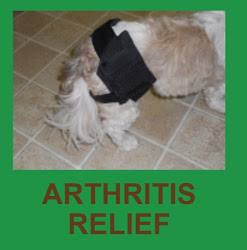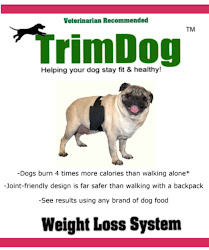*All Sample Applications of the TrimDog Exercise Belt should be used under the direction of a Certified Canine Rehabilitation Practitioner and your veterinarian*
"Gizmo has been using the TrimDog belt to strengthen his rear legs. He had back surgery and his walking ability has improved greatly since his last visit."
Dr. Sybil Davis, DVM, Certified Canine Rehabilitation Practitioner
Osteoarthritis Home Care Program
Heat Belt in microwave for recommended time (see insert) and place on arthritic joints for 15 minutes to warm up the joints prior to short leash walks or to provide temporary pain-relief throughout the day.
Post-op Extracapsular Cranial Cruciate Ligament Repair
Belt may be worn in the latter half of Step 2 (Early weight-bearing) using short 15-30 sec walks with the belt worn towards the rear to promote increased hypertrophy in the hind legs. Early on this exercise can be used as an alternative to inclines if excessive hip and knee extension is painful when walking up inclines. During Step 3 (Consistent Weight-bearing) and Step 4 (Consistent Weight-bearing at a trot) Belt walking with the belt displaced towards the rear can be used interchangeably with inclines to develop the hind leg muscles and short-timed walks 1-3 minutes can be used at home for additional strengthening during non-clinic days. The belt can also be heated and worn at home to prepare the muscles for exercise prior to prescribed short-leash walks on non-clinic days.
Post-op for TPLO
Belt can be heated and worn on desired area to warm-up tissues prior to short leash walk during Step 2 (Discharge from hospital to 3 weeks after surgery) and Step 3. During Step 4 (6-8 weeks after surgery) Belt walks with belt towards rear for 15 sec intervals can be rotated with walking up inclines or stairs to strengthen rear limb muscles. During Step 5 (9-12 weeks out) . Timed walks with belt towards rear can be increased working up to 3-5 minutes multiple times per week at home and belt may be added to Sit-to-Stand Exercises for 5 repetition sets ( 2 sets total) when 20 repetitions of bodyweight can be done with proper form to further increase muscle mass.
Post-op FHO
Step 2: Early Weight-bearing- After acute inflammation has subsided Belt can be heated and worn on desired area to warm-up tissues prior to short leash walk. During Step 3: (Consistent Weight-bearing) Belt walking for 15-30 sec with the belt towards the rear can be used in place of inclines to develop the hind leg muscles. Step 3-Step: Timed walks with belt towards rear can be done working up to 1-5 minutes at a time for multiple times per week at home and belt may be added to Sit-to-Stand Exercises for 5 repetition sets (2 sets total) when 20 repetitions of bodyweight can be done with proper form to further increase muscle mass.
Weight Loss
Multiple walks with the Belt can be done per week for weight loss on dogs that are deemed healthy enough for regular walking programs. Dogs with noticeable OA symptoms should experience enough of a weight loss to allow pain-free exercise prior to using the Belt.
Other Uses:
Timed Walks with Belt placed towards the rear or added to Sit-to-stand exercises to promote muscular strength and to stimulate hind leg development are appropriate in orthopedic cases after the canine has progressed to Consistent Weight-bearing & Weight-bearing at a trot.
Extras:
Exercising with lead-weighted jackets resulted in increased bone mass and reduces bone loss during aging. 1- Pg 151
Low Impact weight-bearing exercise with lead-weighted jackets does not cause alterations of articular cartilage that might lead to joint degeneration. 1-Pg 121
When a dog wears a weighted backpack during sit-to-stand exercises, greater muscle force is required to rise to a standing position. 1- Pg 261
( 1 -“Canine Rehabilitation & Physical Therapy”, Millis, Levine, Taylor)


















